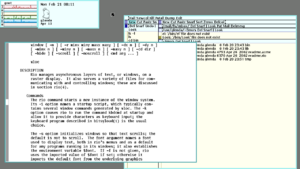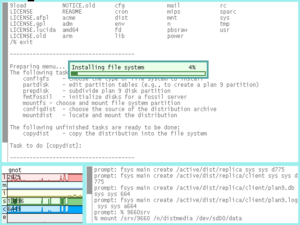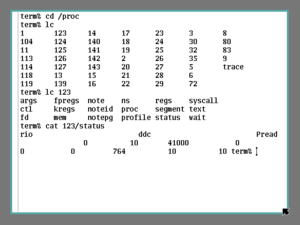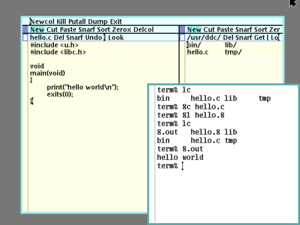Plan 9 from Bell Labs facts for kids

Glenda, the Plan 9 mascot in a space suit, drawn by Renée French
|
|

rio, default user interface of Plan 9 from Bell Labs
|
|
| Company / developer | Plan 9 Foundation, succeeding Bell Labs |
|---|---|
| Programmed in | Dialect of ANSI C |
| Working state | Current |
| Source model | Open source |
| Initial release | 1992 (universities) / 1995 (general public) |
| Discontinued | Fourth Edition / January 10, 2015 |
| Marketing target | Operating systems research, networked environments, general-purpose use |
| Available language(s) | English |
| Supported platforms | x86 / Vx32, x86-64, MIPS, DEC Alpha, SPARC, PowerPC, ARM |
| Kernel type | Monolithic |
| Influenced by | Research Unix, Cambridge Distributed Computing System |
| Default user interface | rio / rc |
| License | 2021: MIT 2014: GPL-2.0-only 2002: LPL-1.02 2000: Plan 9 OSL |
Plan 9 from Bell Labs is a distributed operating system which originated from the Computing Science Research Center (CSRC) at Bell Labs in the mid-1980s and built on UNIX concepts first developed there in the late 1960s. Since 2000, Plan 9 has been free and open-source. The final official release was in early 2015.
Under Plan 9, UNIX's everything is a file metaphor is extended via a pervasive network-centric filesystem, and the cursor-addressed, terminal-based I/O at the heart of UNIX-like operating systems is replaced by a windowing system and graphical user interface without cursor addressing, although rc, the Plan 9 shell, is text-based.
The name Plan 9 from Bell Labs is a reference to the Ed Wood 1957 cult science fiction Z-movie Plan 9 from Outer Space. The system continues to be used and developed by operating system researchers and hobbyists.
Contents
History
Plan 9 from Bell Labs was originally developed, starting in the late 1980s, by members of the Computing Science Research Center at Bell Labs, the same group that originally developed Unix and the C programming language. The Plan 9 team was initially led by Rob Pike, Ken Thompson, Dave Presotto and Phil Winterbottom, with support from Dennis Ritchie as head of the Computing Techniques Research Department. Over the years, many notable developers have contributed to the project, including Brian Kernighan, Tom Duff, Doug McIlroy, Bjarne Stroustrup and Bruce Ellis.
Plan 9 replaced Unix as Bell Labs's primary platform for operating systems research. It explored several changes to the original Unix model that facilitate the use and programming of the system, notably in distributed multi-user environments. After several years of development and internal use, Bell Labs shipped the operating system to universities in 1992. Three years later, Plan 9 was made available for commercial parties by AT&T via the book publisher Harcourt Brace. With source licenses costing $350, AT&T targeted the embedded systems market rather than the computer market at large. Ritchie commented that the developers did not expect to do "much displacement" given how established other operating systems had become.
By early 1996, the Plan 9 project had been "put on the back burner" by AT&T in favor of Inferno, intended to be a rival to Sun Microsystems' Java platform. In the late 1990s, Bell Labs' new owner Lucent Technologies dropped commercial support for the project and in 2000, a third release was distributed under an open-source license. A fourth release under a new free software license occurred in 2002. In early 2015, the final official release of Plan 9 occurred.
A user and development community, including current and former Bell Labs personnel, produced minor daily releases in the form of ISO images. Bell Labs hosted the development. The development source tree is accessible over the 9P and HTTP protocols and is used to update existing installations. In addition to the official components of the OS included in the ISOs, Bell Labs also hosts a repository of externally developed applications and tools.
As Bell Labs has moved on to later projects in recent years, development of the official Plan 9 system had stopped. On March 23, 2021, development resumed following the transfer of copyright from Bell Labs to the Plan 9 Foundation. Unofficial development for the system also continues on the 9front fork, where active contributors provide monthly builds and new functionality. So far, the 9front fork has provided the system Wi-Fi drivers, Audio drivers, USB support and built-in game emulator, along with other features. Other recent Plan 9-inspired operating systems include Harvey OS and Jehanne OS.
| Date | Release | Comment |
|---|---|---|
| 1992 | Plan 9 1st edition | Released by Bell Labs to universities |
| 1995 | Plan 9 2nd edition | Released by Bell Labs for non-commercial purposes |
| 2000 | Plan 9 3rd ed. (Brazil) | Released by Lucent Technologies under an open source license |
| 2002 | Plan 9 4th edition | Released by Lucent Technologies under a new free software license |
Design concepts
Plan 9 is a distributed operating system, designed to make a network of heterogeneous and geographically separated computers function as a single system. In a typical Plan 9 installation, users work at terminals running the window system rio, and they access CPU servers which handle computation-intensive processes. Permanent data storage is provided by additional network hosts acting as file servers and archival storage.
Its designers state that,
[t]he foundations of the system are built on two ideas: a per-process name space and a simple message-oriented file system protocol.
The first idea (a per-process name space) means that, unlike on most operating systems, processes (running programs) each have their own view of the namespace, corresponding to what other operating systems call the file system; a single path name may refer to different resources for different processes. The potential complexity of this setup is controlled by a set of conventional locations for common resources.
The second idea (a message-oriented filesystem) means that processes can offer their services to other processes by providing virtual files that appear in the other processes' namespace. The client process's input/output on such a file becomes inter-process communication between the two processes. This way, Plan 9 generalizes the Unix notion of the filesystem as the central point of access to computing resources. It carries over Unix's idea of device files to provide access to peripheral devices (mice, removable media, etc.) and the possibility to mount filesystems residing on physically distinct filesystems into a hierarchical namespace, but adds the possibility to mount a connection to a server program that speaks a standardized protocol and treat its services as part of the namespace.
For example, the original window system, called 8½, exploited these possibilities as follows. Plan 9 represents the user interface on a terminal by means of three pseudo-files: mouse, which can be read by a program to get notification of mouse movements and button clicks, cons, which can be used to perform textual input/output, and bitblt, writing to which enacts graphics operations (see bit blit). The window system multiplexes these devices: when creating a new window to run some program in, it first sets up a new namespace in which mouse, cons and bitblt are connected to itself, hiding the actual device files to which it itself has access. The window system thus receives all input and output commands from the program and handles these appropriately, by sending output to the actual screen device and giving the currently focused program the keyboard and mouse input. The program does not need to know if it is communicating directly with the operating system's device drivers, or with the window system; it only has to assume that its namespace is set up so that these special files provide the kind of input and accept the kind of messages that it expects.
Plan 9's distributed operation relies on the per-process namespaces as well, allowing client and server processes to communicate across machines in the way just outlined. For example, the cpu command starts a remote session on a computation server. The command exports part of its local namespace, including the user's terminal's devices (mouse, cons, bitblt), to the server, so that remote programs can perform input/output using the terminal's mouse, keyboard and display, combining the effects of remote login and a shared network filesystem.
9P protocol
All programs that wish to provide services-as-files to other programs speak a unified protocol, called 9P. Compared to other systems, this reduces the number of custom programming interfaces. 9P is a generic, medium-agnostic, byte-oriented protocol that provides for messages delivered between a server and a client. The protocol is used to refer to and communicate with processes, programs, and data, including both the user interface and the network. With the release of the 4th edition, it was modified and renamed 9P2000.
Unlike most other operating systems, Plan 9 does not provide special application programming interfaces (such as Berkeley sockets, X resources or ioctl system calls) to access devices. Instead, Plan 9 device drivers implement their control interface as a file system, so that the hardware can be accessed by the ordinary file input/output operations read and write. Consequently, sharing the device across the network can be accomplished by mounting the corresponding directory tree to the target machine.
Union directories and namespaces
Plan 9 allows the user to collect the files (called names) from different directory trees in a single location. The resulting union directory behaves as the concatenation of the underlying directories (the order of concatenation can be controlled); if the constituent directories contain files having the same name, a listing of the union directory (ls or lc) will simply report duplicate names. Resolution of a single path name is performed top-down: if the directories top and bottom are unioned into u with top first, then u/name denotes top/name if it exists, bottom/name only if it exists and top/name does not exist, and no file if neither exists. No recursive unioning of subdirectories is performed, so if top/subdir exists, the files in bottom/subdir are not accessible through the union.
A union directory can be created by using a sequence of bind commands:
bind /arm/bin /bin bind -a /acme/bin/arm /bin bind -b /usr/alice/bin /bin
In the example above, /arm/bin is mounted at /bin, the contents of /arm/bin replacing the previous contents of /bin. Acme's bin directory is then union mounted after /bin, and Alice's personal bin directory is union mounted before. When a file is requested from /bin, it is first looked for in /usr/alice/bin, then in /arm/bin, and then finally in /acme/bin/arm.
The separate process namespaces thus usually replace the notion of a search path in the shell. A path environment variable ($path/bin./bin
Furthermore, the kernel can keep separate mount tables for each process, and can thus provide each process with its own file system namespace. Processes' namespaces can be constructed independently, and the user may work simultaneously with programs that have heterogeneous namespaces. Namespaces may be used to create an isolated environment similar to chroot, but in a more secure way.
Plan 9's union directory architecture inspired 4.4BSD and Linux union file system implementations, although the developers of the BSD union mounting facility found the non-recursive merging of directories in Plan 9 "too restrictive for general purpose use".
Special virtual filesystem
/proc
Instead of having system calls specifically for process management, Plan 9 provides the /proc file system. Each process appears as a directory containing information and control files which can be manipulated by the ordinary file IO system calls.
The file system approach allows Plan 9 processes to be managed with simple file management tools such as ls and cat; however, the processes cannot be copied and moved as files.
/net
Plan 9 does not have specialised system calls or ioctls for accessing the networking stack or networking hardware. Instead, the /net file system is used. Network connections are controlled by reading and writing control messages to control files. Sub-directories such as /net/tcp and /net/udp are used as an interface to their respective protocols.
Unicode
To reduce the complexity of managing character encodings, Plan 9 uses Unicode throughout the system. The initial Unicode implementation was ISO/IEC 10646-1:1993. Ken Thompson invented UTF-8, which became the native encoding in Plan 9. The entire system was converted to general use in 1992. UTF-8 preserves backwards compatibility with traditional null-terminated strings, enabling more reliable information processing and the chaining of multilingual string data with Unix pipes between multiple processes. Using a single UTF-8 encoding with characters for all cultures and regions eliminates the need for switching between code sets.
Combining the design concepts
Though interesting on their own, the design concepts of Plan 9 were supposed to be most useful when combined. For example, to implement a network address translation (NAT) server, a union directory can be created, overlaying the router's /net directory tree with its own /net. Similarly, a virtual private network (VPN) can be implemented by overlaying in a union directory a /net hierarchy from a remote gateway, using secured 9P over the public Internet. A union directory with the /net hierarchy and filters can be used to sandbox an untrusted application or to implement a firewall. In the same manner, a distributed computing network can be composed with a union directory of /proc hierarchies from remote hosts, which allows interacting with them as if they are local.
When used together, these features allow for assembling a complex distributed computing environment by reusing the existing hierarchical name system.
Software for Plan 9
As a benefit from the system's design, most tasks in Plan 9 can be accomplished by using ls, cat, grep, cp and rm utilities in combination with the rc shell (the default Plan 9 shell).
Factotum is an authentication and key management server for Plan 9. It handles authentication on behalf of other programs such that both secret keys and implementation details need only be known to Factotum.
Graphical programs
Unlike Unix, Plan 9 was designed with graphics in mind. After booting, a Plan 9 terminal will run the rio windowing system, in which the user can create new windows displaying rc. Graphical programs invoked from this shell replace it in its window.
The plumber provides an inter-process communication mechanism which allows system-wide hyperlinking.
Sam and acme are Plan 9's text editors.
Storage system
Plan 9 supports the Kfs, Paq, Cwfs, FAT, and Fossil file systems. The last was designed at Bell Labs specifically for Plan 9 and provides snapshot storage capability. It can be used directly with a hard drive or backed with Venti, an archival file system and permanent data storage system.
Software development
The distribution package for Plan 9 includes special compiler variants and programming languages, and provides a tailored set of libraries along with a windowing user interface system specific to Plan 9. The bulk of the system is written in a dialect of C (ANSI C with some extensions and some other features left out). The compilers for this language were custom built with portability in mind; according to their author, they "compile quickly, load slowly, and produce medium quality object code".
A concurrent programming language called Alef was available in the first two editions, but was then dropped for maintenance reasons and replaced by a threading library for C.
Unix compatibility
Though Plan 9 was supposed to be a further development of Unix concepts, compatibility with preexisting Unix software was never the goal for the project. Many command-line utilities of Plan 9 share the names of Unix counterparts, but work differently.
Plan 9 can support POSIX applications and can emulate the Berkeley socket interface through the ANSI/POSIX Environment (APE) that implements an interface close to ANSI C and POSIX, with some common extensions (the native Plan 9 C interfaces conform to neither standard). It also includes a POSIX-compatible shell. APE's authors claim to have used it to port the X Window System (X11) to Plan 9, although they do not ship X11 "because supporting it properly is too big a job". Some Linux binaries can be used with the help of a "linuxemu" (Linux emulator) application; however, it is still a work in progress. Vice versa, the Vx32 virtual machine allows a slightly modified Plan 9 kernel to run as a user process in Linux, supporting unmodified Plan 9 programs.
License
Starting with the release of Fourth edition in April 2002, the full source code of Plan 9 from Bell Labs is freely available under Lucent Public License 1.02, which is considered to be an open-source license by the Open Source Initiative (OSI), free software license by the Free Software Foundation, and it passes the Debian Free Software Guidelines.
In February 2014, the University of California, Berkeley, was authorized by the current Plan 9 copyright holder – Alcatel-Lucent – to release all Plan 9 software previously governed by the Lucent Public License, Version 1.02 under the GPL-2.0-only.
On March 23, 2021, ownership of Plan 9 transferred from Bell Labs to the Plan 9 Foundation, and all previous releases have been relicensed to the MIT License.
See also
 In Spanish: Plan 9 para niños
In Spanish: Plan 9 para niños
- Alef (programming language)
- Rendezvous (Plan 9)
- Inferno (operating system)
- Redox (operating system)
- Minix
- HelenOS




